Integrating Web-Based Weather Data into Building Information Modeling Models through Robot Process Automation
Abstract
:1. Introduction
- Parametric visual programming tools: As reviewed in [35], parametric programming tools, such as Dynamo and Grasshopper, are commonly employed in civil engineering and architectural applications by enabling automation, optimization, and data-driven decision-making. Parametric programming tools have found common applications in the literature, including in (1) facilitating generative geometrical design, allowing for the creation of intricate geometries. For example, Korus et al. [36], used Dynamo scripts to program the geometry of complex arch bridges. (2) Automating repetitive tasks in BIM software like Revit. A practical application can be found in Atencio et al. [37], who employed Dynamo tools to automate hydraulic service connections within BIM buildings. (3) Enhancing data analysis capabilities within BIM models, as exemplified by Demirdöğen et al. [38], who used Dynamo codes to manage healthcare facilities. (4) Improving interoperability between different software applications and formats. For instance, Lozano et al. [34] used Dynamo to automate data exchange and synchronization between BIM software and Excel databases for sustainable bridge assessment, while Kensek [39] integrated environmental sensor measurements into BIM using Dynamo. (5) Enhancing construction and fabrication, as demonstrated by Liu et al. [40], who optimized steel fabrication processes through the utilization of Dynamo. And finally, (6) the creation of customized parametric families. For example, Lozano et al. [10] employed Dynamo to create parametric structural families for damaged elements in a suspension bridge;
- Robot Process Automation (RPA) protocols: RPA refers to an advanced technology that automates tasks traditionally performed by humans by replicating user interface interactions, following business rules and activity structures [41]. This emulation of human activities offers advantages such as enhanced efficiency, reduced errors, and increased productivity [42]. A comprehensive exploration of RPA’s applications across various industries, including banking, healthcare, and manufacturing, is provided in [42]. In the construction domain, the limited utilization of this technology is exemplified by Atencio et al.’s work [43], in which they proposed automating the management of low-cost sensors for dynamic structure monitoring using RPA tools. Despite its potential applications, there is a scarcity of prior literature introducing the use of RPA for BIM model calibration. Notably, the literature review carried out on BIM and RPA applications yielded only non-peer-reviewed work by Jiang and Ling [44], who suggested employing RPA to automate building equipment operations in BIM models. According to Syed et al. [45], the benefits of RPA include (1) a user-friendly interface, (2) faster and more streamlined programming compared to Dynamo and Python, and (3) direct execution in productive environments. Additionally, as stated by Karn and Kotecha [46], RPA can effectively complement Internet of Things (IoT) protocols.
2. Background
2.1. Weather Data
2.1.1. Weather Information on Websites
2.1.2. Hazardous Weather Alerts
2.1.3. Weather Information Extraction
2.2. From BIM Models to Digital Twins
2.3. RPA and Its Potential for the AEC Industry
2.4. Weather Data with RPA
3. Automated BIM-Based Alarm System
3.1. Research Method
3.2. Developed Tool
- Weather information extraction: This RPA protocol is configured to periodically access the established weather websites and extract the weather data. Then, this information is organized and stored within an Excel spreadsheet located in the Google Drive cloud (Google Sheets). This sheet is programmed with the hazardous weather criteria to identify potential alerts. It is worth noting that the frequency with which the weather information is updated varies across different sites, necessitating distinct time-triggers within the RPA program;
- Alert dispatch: In this step, the RPA protocol checks the weather analyses in Excel. In those cases where the predefined thresholds are surpassed, an RPA is programmed to transmit digital alerts to the stakeholders via email using Gmail;
- Integration of weather data into the BIM model: This RPA protocol automates the introduction of the weather data collected in Step 1 into the BIM model;
- Integration of BIM information into the weather database: This RPA protocol facilitates the export of BIM information that may be necessary for analyzing hazardous weather conditions to the Excel sheet containing the weather data.
- Access the Google Sheet containing the weather data and read the parameters, alerts along with their respective values/severity levels;
- Create shared parameters for the weather data and incorporate their respective values/severity levels;
- Create filters for the BIM mass model to depict the severity of the weather alerts and apply the data to different scenarios.
4. Case Study
4.1. Description of the Structure and BIM Model
4.2. Weather Information Analysis
4.3. Robot Process Automation (RPA) Protocol
- Weather information extraction: The RPA reads the weather information according to the predefined time triggers outlined in Table 1 and stores it within a Google Sheet hosted on a Google Drive account. This information encompasses various weather parameters, including temperature, humidity, rainfall, wind speed, wind direction, and wave height, along with their respective timestamps and update intervals. Additionally, it incorporates the studied weather hazards (fire, wind, and swell conditions) and the associated severity levels (normal, warning, or danger), as calculated from Table 2 and Table 3. A screenshot of the Google sheet used is presented in Figure 8;
- Alert dispatch: In those cases where the predefined thresholds are surpassed, the RPA is programmed to transmit digital alerts to the stakeholders via Gmail;
- Integration of weather data into the BIM model: The RPA lunches a Dynamo script to automate the introduction and representation of the weather data collected in Step 1 into the BIM model.
- Open the Google Sheet with the weather data and read the information provided for the weather parameters, alerts, and their respective values/severity levels;
- Create a shared parameter for each of the parameters identified in Step 1, and associate them with their respective values/severity levels. This step also encompasses defining the parameter type;
- Create filters to represent the severity levels of the analyzed hazards into defined views of the BIM mass model. Different colors are used for each of the severity levels (green for normal, yellow for warning, and red for danger). To illustrate the representation of wind direction, these filters consider the orientation of the model, displaying the wind’s impact solely on the affected façade.
4.4. Results
5. Discussion
Future Research
- The exploration and evaluation of other processes in the AEC field to be automated. Every AEC enterprise comprises a set of business processes supporting the project development, such as procurement, invoice processing, payment, project reports, etc. When the project increases in complexity, these processes produce a large volume of transactions, requiring significant manual work. This complexity makes tasks susceptible to errors and creates bottlenecks due to a lack of operational capability. Therefore, there is a fertile field of research on the automation of AEC processes and achieving higher levels of efficiency. This research could also impact the current low productivity levels and digitalization of the AEC sector;
- The integration of RPA and AI has the potential to revolutionize numerous aspects of the AEC industry. RPA enhances process automation by managing routine tasks such as invoicing, data extraction, and report generation. Meanwhile, AI adds substantial value by predicting trends and providing actionable insights derived from data analysis. Another significant application of these technologies is in predictive maintenance, where historical data are utilized to forecast equipment failures or maintenance needs, thereby reducing downtime and extending asset lifespans. AI-driven chatbots and virtual assistants further improve customer service by handling inquiries, offering real-time support, and enhancing overall customer experience. Additionally, these technologies excel in data analysis and visualization, processing large datasets to uncover patterns and generate reports that support informed decision-making;
- In the specific context of weather forecasting, RPA and AI can markedly enhance both the accuracy and efficiency of data collection and analysis. RPA automates data collection by integrating weather information from various sources into a centralized system, thereby improving the quality and comprehensiveness of forecasts. AI algorithms, on the other hand, process real-time weather data to produce up-to-date predictions. Machine learning models continuously refine these forecasts based on new data, enhancing their accuracy. Furthermore, AI’s ability to analyze historical weather data reveals long-term trends and patterns, providing valuable insights into climate change and future weather scenarios. AI is also adept at detecting anomalies in weather patterns, such as unusual temperature fluctuations or extreme weather events, which enables timely warnings and improves project planning and scheduling;
- RPA tools, such as UiPath, which is applied in this research, have recently integrated more advanced AI capabilities into their platforms, enhancing the ability of businesses to automate complex tasks that require cognitive skills [104]. Integrating AI-driven models, such as natural language processing (NLP), computer vision, and machine learning, allows RPA bots to understand unstructured data, process documents intelligently, and make data-driven decisions in real time. These advancements are a step toward building hyper-automation solutions, where AI, alongside RPA, facilitates end-to-end automation processes, improving efficiency, accuracy, and scalability across industries [105];
- RPA technology allows users to perform automatic activities through the development of several bots working in coordination and supervised by other bots. Since processes should operate interrelatedly, RPA processes should also work through an orchestrated operation. This type of RPA use is known as RPA orchestration, and there is no evidence in the literature of studies related to the AEC field, opening new research avenues;
- Emerging technologies require new capabilities to implement and manage them over time. The current knowledge about RPA lacks a discussion of how this technology should be installed sustainably in the AEC sector, considering its particularities in terms of activities. Similarly other industries that are more mature in their use of this technology, RPA’s roles should be defined with a robust knowledge of the technology and AEC-related processes. Future research could develop a framework to implement and manage RPA technology in the sector. This research could use the BIM technology and BIM roles framework as a reference. Moreover, the interoperability of RPA with AEC-related technologies must be considered.
6. Conclusions
- Dependency on external data sources: The RPA’s effectiveness relies heavily on the availability and accuracy of weather data from external websites. Changes in the data source’s structure, such as updates to website layout or data format, could disrupt the extraction process and require adjustments to the RPA. To address this issue, the use of in situ sensors should be studied in future works;
- Software: The proposed application is currently restricted to Autodesk software, specifically Dynamo and Revit. To extend functionality to other BIM programs, a thorough examination of interoperability between different software platforms is necessary. This would involve revising both the parametric programming algorithms and the RPA protocol to accommodate diverse BIM environments;
- Scalability and adaptability: The application of the proposed methodology may face challenges when applied to different geographic locations or scales. Variations in local weather data sources, reporting standards, or project requirements could necessitate modifications to the RPA protocol to maintain functionality and accuracy;
- Maintenance and monitoring: Ongoing maintenance is crucial to ensure that the RPA performs effectively. This includes monitoring for updates or changes in the external websites, adjusting the protocol to handle new data formats, and ensuring compatibility with evolving versions of Dynamo and Revit.
Author Contributions
Funding
Institutional Review Board Statement
Informed Consent Statement
Data Availability Statement
Acknowledgments
Conflicts of Interest
References
- Pereiro, X.; Cabaleiro, M.; Conde, B. BIM Methodology for Cost Analysis, Sustainability, and Management of Steel Structures with Reconfigurable Joints for Industrial Structures. J. Build. Eng. 2023, 77, 107443. [Google Scholar] [CrossRef]
- Wang, Y.; Zhuang, J.; Zhou, G.; Wang, S. Research on Unbalanced Mining of Highway Project Key Data Based on Knowledge Graph and Cloud Model. Alex. Eng. J. 2023, 68, 67–81. [Google Scholar] [CrossRef]
- Amer, M.; Naaman, A.; M’Sirdi, N.K.; El-Zonkoly, A.M. Smart Home Energy Management Systems Survey. In Proceedings of the International Conference on Renewable Energies for Developing Countries 2014, Beirut, Lebanon, 26–27 November 2014; pp. 167–173. [Google Scholar] [CrossRef]
- Caglayan, S.; Ozorhon, B. Automation in Construction Determining Building Information Modeling Effectiveness. Autom. Constr. 2023, 151, 104861. [Google Scholar] [CrossRef]
- Opoku, D.J.; Perera, S.; Osei-kyei, R.; Rashidi, M. Digital Twin Application in the Construction Industry: A Literature Review. J. Build. Eng. 2021, 40, 102726. [Google Scholar] [CrossRef]
- Zhang, T.; Tien, D.; Kang, J. Application of Building Information Modeling-Blockchain Integration in the Architecture, Engineering, and Construction/Facilities Management Industry: A Review. J. Build. Eng. 2023, 77, 107551. [Google Scholar] [CrossRef]
- Tuhaise, V.V.; Handibry, J.; Tah, M.; Abanda, F.H. Automation in Construction Technologies for Digital Twin Applications in Construction. Autom. Constr. 2023, 152, 104931. [Google Scholar] [CrossRef]
- Hadjidemetriou, L.; Stylianidis, N.; Englezos, D.; Papadopoulos, P.; Eliades, D.; Timotheou, S.; Polycarpou, M.M.; Panayiotou, C. A Digital Twin Architecture for Real-Time and Offline High Granularity Analysis in Smart Buildings. Sustain. Cities Soc. 2023, 98, 104795. [Google Scholar] [CrossRef]
- Amin, A.; Ansari, R.; Taherkhani, R.; Hosseini, M.R. Developing a Novel Cash Flow Risk Analysis Framework for Construction Projects Based on 5D BIM. J. Build. Eng. 2021, 44, 103341. [Google Scholar] [CrossRef]
- Lozano, F. Automatic Calibration and Sustainability Assessment of BIM Digital Twins with Smart Low-Cost Sensors Information. Ph.D. Dissertation, Universidad de Castilla-La Mancha, Ciudad Real, Castilla-La Mancha, Spain, 23 May 2024. [Google Scholar]
- Zaalouk, A.; Moon, S.; Han, S. Automation in Construction Operations Planning and Scheduling in Off-Site Construction Supply Chain Management: Scope Definition and Future Directions. Autom. Constr. 2023, 153, 104952. [Google Scholar] [CrossRef]
- Lim, Y.W.; Chong, H.Y.; Ling, P.C.H.; Tan, C.S. Greening Existing Buildings through Building Information Modelling: A Review of the Recent Development. Build. Environ. 2021, 200, 107924. [Google Scholar] [CrossRef]
- Soust-verdaguer, B.; Galeana, I.B.; Llatas, C.; Montes, M. V How to Conduct Consistent Environmental, Economic, and Social Assessment during the Building Design Process. A BIM-Based Life Cycle Sustainability Assessment Method. J. Build. Eng. 2022, 45, 103516. [Google Scholar] [CrossRef]
- Zheng, L.; Lu, W.; Wu, L.; Zhou, Q. A Review of Integration between BIM and CFD for Building Outdoor Environment Simulation. Build. Environ. 2023, 228, 109862. [Google Scholar] [CrossRef]
- Lozano-Galant, J.A.; Turmo, J. Traffic Road Emission Estimation Through Visual Programming Algorithms and Building Information Models: A Case Study. IEEE Access 2021, 9, 150846–150864. [Google Scholar] [CrossRef]
- Zhang, S.; Sulankivi, K.; Kiviniemi, M.; Romo, I.; Eastman, C.M.; Teizer, J. BIM-Based Fall Hazard Identification and Prevention in Construction Safety Planning. Saf. Sci. 2015, 72, 31–45. [Google Scholar] [CrossRef]
- Xu, F.; Liu, Q. Building Energy Consumption Optimization Method Based on Convolutional Neural Network and BIM. Alex. Eng. J. 2023, 77, 407–417. [Google Scholar] [CrossRef]
- Sabah Haseeb, Q.; Muhammed Yunus, S.; Attellah Ali Shoshan, A.; Ibrahim Aziz, A. A Study of the Optimal Form and Orientation for More Energy Efficiency to Mass Model Multi-Storey Buildings of Kirkuk City, Iraq. Alex. Eng. J. 2023, 71, 731–741. [Google Scholar] [CrossRef]
- Weather.Com. Available online: https://weather.com/weather/today/l/4494c890282e298d87b54d1ea711a4a05e54af783093a426fe8a4bfce11c306b98df80728f406b3a773c3bd6afebff2b (accessed on 18 September 2023).
- AccuWeather. Available online: https://www.accuweather.com/es/es/barcelona/307297/weather-forecast/307297 (accessed on 28 September 2023).
- Diz-Mellado, E.; López-Cabeza, V.P.; Rivera-Gómez, C.; Galán-Marín, C. Seasonal Analysis of Thermal Comfort in Mediterranean Social Courtyards: A Comparative Study. J. Build. Eng. 2023, 78, 107756. [Google Scholar] [CrossRef]
- Xiong, F.; Wen, H.; Zhang, C.; Song, C.; Zhou, X. Semantic Segmentation Recognition Model for Tornado-Induced Building Damage Based on Satellite Images. J. Build. Eng. 2022, 61, 105321. [Google Scholar] [CrossRef]
- BBC Chile Forest Fires: More Than 100 Dead in Valparaíso Region. Available online: https://www.bbc.com/news/world-latin-america-68196048 (accessed on 12 February 2024).
- Shirowzhan, S.; Sepasgozar, S.M.E.; Edwards, D.J.; Li, H.; Wang, C. Automation in Construction BIM Compatibility and Its Differentiation with Interoperability Challenges as an Innovation Factor. Autom. Constr. 2020, 112, 103086. [Google Scholar] [CrossRef]
- State, P. Penn State BIM Uses. Available online: https://bim.psu.edu/uses/ (accessed on 7 October 2022).
- Ceranic, B.; Beardmore, J.; Cox, A. Rapid Deployment Modular Building Solutions and Climatic Adaptability: Case Based Study of a Novel Approach to “Thermal Capacity on Demand”. Energy Build. 2018, 167, 124–135. [Google Scholar] [CrossRef]
- Larsen, K.E.; Lattke, F.; Ott, S.; Winter, S. Surveying and Digital Workflow in Energy Performance Retrofit Projects Using Prefabricated Elements. Autom. Constr. 2011, 20, 999–1011. [Google Scholar] [CrossRef]
- Hou, F.; Ma, J.; Kwok, H.H.L.; Cheng, J.C.P. Prediction and Optimization of Thermal Comfort, IAQ and Energy Consumption of Typical Air-Conditioned Rooms Based on a Hybrid Prediction Model. Build. Environ. 2022, 225, 109576. [Google Scholar] [CrossRef]
- Rashidian, S.; Drogemuller, R.; Omrani, S. Compatibility of Existing Bim Maturity Models With Lean Construction and Integrated Project Delivery. J. Inf. Technol. Constr. 2022, 27, 496–511. [Google Scholar] [CrossRef]
- Autodesk Energy Performance and Climate in BIM. Available online: https://www.autodesk.com/support/technical/article/caas/tsarticles/ts/1jpr14GEK6qUEyQgPzhIdr.html (accessed on 9 October 2023).
- Mobaraki, B.; Lozano-Galant, F.; Soriano, R.P.; Castilla Pascual, F.J. Application of Low-Cost Sensors for Building Monitoring: A Systematic Literature Review. Buildings 2021, 11, 336. [Google Scholar] [CrossRef]
- Zahid, H.; Elmansoury, O.; Yaagoubi, R. Dynamic Predicted Mean Vote: An IoT-BIM Integrated Approach for Indoor Thermal Comfort Optimization. Autom. Constr. 2021, 129, 103805. [Google Scholar] [CrossRef]
- Birgonul, Z. A Receptive-Responsive Tool for Customizing Occupant’s Thermal Comfort and Maximizing Energy Efficiency by Blending BIM Data with Real-Time Information. Smart Sustain. Built Environ. 2021, 10, 504–535. [Google Scholar] [CrossRef]
- Shaharuddin, S.; Abdul Maulud, K.N.; Syed Abdul Rahman, S.A.F.; Che Ani, A.I.; Pradhan, B. The Role of IoT Sensor in Smart Building Context for Indoor Fire Hazard Scenario: A Systematic Review of Interdisciplinary Articles. Internet Things 2023, 22, 100803. [Google Scholar] [CrossRef]
- Collao, J.; Lozano-galant, F.; Lozano-galant, J.A. BIM Visual Programming Tools Applications in Infrastructure Projects: A State-of-the-Art Review. Appl. Sci. 2021, 11, 8343. [Google Scholar] [CrossRef]
- Korus, K.; Salamak, M. Optimization of Geometric Parameters of Arch Bridges Using Visual Programming FEM Components and Genetic Algorithm. Eng. Struct. J. 2021, 241, 112465. [Google Scholar] [CrossRef]
- Atencio, E.; Araya, P.; Oyarce, F.; Herrera, R.F.; Rivera, F.M.; Lozano-galant, F. Towards the Integration and Automation of the Design Process for Domestic Drinking-Water and Sewerage Systems with BIM. Appl. Sci. 2022, 12, 9063. [Google Scholar] [CrossRef]
- Demirdöğen, G.; Işık, Z.; Arayici, Y. BIM-Based Big Data Analytic System for Healthcare Facility Management. J. Build. Eng. 2023, 64, 105713. [Google Scholar] [CrossRef]
- Integration of Environmental Sensors with BIM: Case Studies Using Arduino, Dynamo, and the Revit API. Available online: https://informesdelaconstruccion.revistas.csic.es/index.php/informesdelaconstruccion/article/view/3575/4027 (accessed on 28 September 2023).
- Liu, Y.; Li, M.; Wong, B.C.L.; Chan, C.M.; Cheng, J.C.P.; Gan, V.J.L. BIM-BVBS Integration with OpenBIM Standards for Automatic Prefabrication of Steel Reinforcement. Autom. Constr. 2021, 125, 103654. [Google Scholar] [CrossRef]
- Asatiani, A.; Penttinen, E. Turning Robotic Process Automation into Commercial Success—Case OpusCapita. J. Inf. Technol. Teach. Cases 2016, 6, 67–74. [Google Scholar] [CrossRef]
- Ng, K.K.H.; Chen, C.H.; Lee, C.K.M.; Jiao, J.; Yang, Z.X. A Systematic Literature Review on Intelligent Automation: Aligning Concepts from Theory, Practice, and Future Perspectives. Adv. Eng. Inform. 2021, 47, 101246. [Google Scholar] [CrossRef]
- Atencio, E.; Komarizadehasl, S.; Lozano-Galant, J.A.; Aguilera, M. Using RPA for Performance Monitoring of Dynamic SHM Applications. Buildings 2022, 12, 1140. [Google Scholar] [CrossRef]
- Jiang, H.; Ling, R. Using RPA+BIM for High Efficient Operation of Smart Building’s Equipment Room. Preprint 2022, 2022100045. [Google Scholar] [CrossRef]
- Syed, R.; Suriadi, S.; Adams, M.; Bandara, W.; Leemans, S.J.J.; Ouyang, C.; ter Hofstede, A.H.M.; van de Weerd, I.; Wynn, M.T.; Reijers, H.A. Robotic Process Automation: Contemporary Themes and Challenges. Comput. Ind. 2020, 115, 103162. [Google Scholar] [CrossRef]
- Karn, S.; Kotecha, R. RPA-Based Implementation of IoT. SSRN Electron. J. 2021. [Google Scholar] [CrossRef]
- Spark, W. Climate and Average Weather Year Round in Viña Del Mar. Available online: https://weatherspark.com/y/25809/Average-Weather-in-Viña-del-Mar-Chile-Year-Round (accessed on 24 October 2023).
- Channel, T.W. Viña Del Mar Weather. Available online: https://weather.com/en-MT/weather/radar/interactive/l/6e23b2ba9a8b4e1124f4a09b2c1b01dc6a9e265569a816f505a0300fe40641a9 (accessed on 24 October 2023).
- Tiempo3 Pronóstico Del Tiempo Viña Del Mar. Available online: https://www.tiempo3.com/south-america/chile/valparaiso/vina-del-mar?page=today (accessed on 24 October 2023).
- Windfinder. Windfinder Weather Data. Available online: https://es.windfinder.com/forecast/vina_del_mar_valparaiso_chile (accessed on 24 October 2023).
- Winckler, P.; Contreras-López, M.; Garreaud, R.; Meza, F. Analysis of Climate-Related Risks for Chile ’ s Coastal Settlements in the ARClim Web Platform. Water 2022, 14, 3594. [Google Scholar] [CrossRef]
- Winckler, P. Nuevas Metodologías Para El Estudio de Marejadas En Chile. In La Zona Costera en Chile: Adaptación y Planificación para la Resiliencia; Martínez, C., Hidalgo, R., Henríquez, C., Arenas, F., Rangel-Buitrago, N., Contreras-López, M., Eds.; CIGIDEN: Santiago de Chile, Chile, 2019; pp. 51–78. ISBN 9789561424425. [Google Scholar]
- NOAA. NOAA Satellites Track Blazing Wildfires in Chile. Available online: https://www.nesdis.noaa.gov/news/noaa-satellites-track-blazing-wildfires-chile (accessed on 10 October 2023).
- Zacharakis, I.; Tsihrintzis, V.A. Integrated Wildfire Danger Models and Factors: A Review. Sci. Total Environ. 2023, 899, 165704. [Google Scholar] [CrossRef]
- Karimiziarani, M.; Jafarzadegan, K.; Abbaszadeh, P.; Shao, W.; Moradkhani, H. Hazard Risk Awareness and Disaster Management: Extracting the Information Content of Twitter Data. Sustain. Cities Soc. 2022, 77, 103577. [Google Scholar] [CrossRef]
- X X: Happening Now. Available online: https://twitter.com/?lang=es (accessed on 12 February 2024).
- Atencio, E.; Muñoz-La Rivera, F.; Mancini, M.; Bustos, G. Towards the Integration Between Construction Projects and the Organization: The Connections Between BIM and Enterprise Architecture. In Complexity and Sustainability in Megaprojects—MerIT; Favari, E., Cartoni, F., Eds.; Springer: Cham, Switzerland; Milan, Italy, 2022; pp. 161–176. [Google Scholar] [CrossRef]
- Xia, H.; Liu, Z.; Efremochkina, M.; Liu, X.; Lin, C. Study on City Digital Twin Technologies for Sustainable Smart City Design: A Review and Bibliometric Analysis of Geographic Information System and Building Information Modeling Integration. Sustain. Cities Soc. 2022, 84, 104009. [Google Scholar] [CrossRef]
- Shafto, M.; Conroy, M.; Rich, D.; Glaessgen, E.; Kemp, C.; LeMougne, J.; Wang, L. DRAFT Modeling, Simulation, Information Technology & Processing Roadmap; NASA, Ed.; NASA: Washington, DC, USA, 2010. [Google Scholar]
- Wei, Y.; Hu, T.; Dong, L.; Ma, S. Digital Twin-Driven Manufacturing Equipment Development. Robot. Comput. Integr. Manuf. 2023, 83, 102557. [Google Scholar] [CrossRef]
- Zhang, J.; Cui, H.; Yang, A.L.; Gu, F.; Shi, C.; Zhang, W.; Niu, S. An Intelligent Digital Twin System for Paper Manufacturing in the Paper Industry. Expert Syst. Appl. 2023, 230, 120614. [Google Scholar] [CrossRef]
- Mukherjee, P.P.; Afroj, M.; Hossain, S.; Biswas, M. Towards a Digital Twin Integrated DLT and IoT-Based Automated Healthcare Ecosystem. In Recent Trends in Image Processing and Pattern Recognition. RTIP2R 2022; Communications in Computer and Information Science Series; Springer: Cham, Switzerland, 2023; Volume 1704, pp. 311–323. [Google Scholar] [CrossRef]
- Pesantez, J.E.; Alghamdi, F.; Sabu, S.; Mahinthakumar, G.; Berglund, E.Z. Using a Digital Twin to Explore Water Infrastructure Impacts during the COVID-19 Pandemic. Sustain. Cities Soc. 2022, 77, 103520. [Google Scholar] [CrossRef]
- Li, Y.; Liu, W.; Zhang, Y.; Zhang, W.; Gao, C.; Chen, Q.; Ji, Y. Interactive Real-Time Monitoring and Information Traceability for Complex Aircraft Assembly Field Based on Digital Twin. IEEE Trans. Ind. Inform. 2023, 19, 9745–9756. [Google Scholar] [CrossRef]
- Wang, F.; Gan, T.; Wang, Y.; Jin, J. Key Technology of Digital Twin System for Aero-Engine Combustors. Hangkong Dongli Xuebao/J. Aerosp. Power 2023, 38, 776–790. [Google Scholar] [CrossRef]
- Vaccari, M.; Pannocchia, G.; Tognotti, L.; Paci, M. Rigorous Simulation of Geothermal Power Plants to Evaluate Environmental Performance of Alternative Configurations. Renew. Energy 2023, 207, 471–483. [Google Scholar] [CrossRef]
- Sifat, M.M.H.; Choudhury, S.M.; Das, S.K.; Ahamed, M.H.; Muyeen, S.M.; Hasan, M.M.; Ali, M.F.; Tasneem, Z.; Islam, M.M.; Islam, M.R.; et al. Towards Electric Digital Twin Grid: Technology and Framework Review. Energy AI 2023, 11, 100213. [Google Scholar] [CrossRef]
- Smeets, J.; Öztürk, K.; Liebich, R. Digital Twins for Automotive Development: Two Wheelers Application. Adv. Eng. Inform. 2023, 56, 101982. [Google Scholar] [CrossRef]
- Li, Y.; Zhang, W. Traffic Flow Digital Twin Generation for Highway Scenario Based on Radar-Camera Paired Fusion. Sci. Rep. 2023, 13, 642. [Google Scholar] [CrossRef]
- Cacciuttolo, C.; Guzmán, V.; Catriñir, P.; Atencio, E.; Komarizadehasl, S.; Lozano-Galant, J.A. Low-Cost Sensors Technologies for Monitoring Sustainability and Safety Issues in Mining Activities: Advances, Gaps, and Future Directions in the Digitalization for Smart Mining. Sensors 2023, 23, 6846. [Google Scholar] [CrossRef] [PubMed]
- Elbazi, N.; Tigami, A.; Laayati, O.; El Maghraoui, A.; Chebak, A.; Mabrouki, M. Digital Twin-Enabled Monitoring of Mining Haul Trucks with Expert System Integration: A Case Study in an Experimental Open-Pit Mine. In Proceedings of the 2023 5th Global Power, Energy and Communication Conference (GPECOM), Nevsehir, Turkiye, 14–16 June 2023; Institute of Electrical and Electronics Engineers Inc.: Piscataway, NJ, USA, 2023; pp. 168–174, ISBN 979-8-3503-0199-1. [Google Scholar]
- Weil, C.; Bibri, S.E.; Longchamp, R.; Golay, F.; Alahi, A. Urban Digital Twin Challenges: A Systematic Review and Perspectives for Sustainable Smart Cities. Sustain. Cities Soc. 2023, 99, 104862. [Google Scholar] [CrossRef]
- Muñoz La Rivera, F.; Atencio, E.; Mora-Serrano, J. Extended Reality (XR) as an Interaction Tool for Digital Twins: Application to Safety Management in Construction Megaprojects. In International Workshop on A Multidisciplinary Approach to Embrace Complexity and Sustainability in Megaprojects, MERIT 2022; Favari, E., Cantoni, F., Eds.; Springer: Milan, Italy, 2022. [Google Scholar] [CrossRef]
- Zhong, C.; Cheng, S.; Kasoar, M.; Arcucci, R. Reduced-Order Digital Twin and Latent Data Assimilation for Global Wildfire Prediction. Nat. Hazards Earth Syst. Sci. 2023, 23, 1755–1768. [Google Scholar] [CrossRef]
- Kampczyk, A.; Dybeł, K. The Fundamental Approach of the Digital Twin Application in Railway Turnouts with Innovative Monitoring of Weather Conditions. Sensors 2021, 21, 5757. [Google Scholar] [CrossRef]
- Chowdhury, P.; Lakku, N.K.G.; Lincoln, S.; Seelam, J.K.; Behera, M.R. Climate Change and Coastal Morphodynamics: Interactions on Regional Scales. Sci. Total Environ. 2023, 899, 166432. [Google Scholar] [CrossRef]
- Adade, D.; de Vries, W.T. Digital Twin for Active Stakeholder Participation in Land-Use Planning. Land 2023, 12, 538. [Google Scholar] [CrossRef]
- Gartner Digital Twin Definition. Available online: https://www.gartner.com/en/information-technology/glossary/digital-twin#:~:text=Adigitaltwinisa,organization%2Cpersonorotherabstraction (accessed on 2 September 2023).
- Kritzinger, W.; Karner, M.; Traar, G.; Henjes, J.; Sihn, W.; Kritzinger, W.; Karner, M.; Traar, G.; Henjes, J.; Sihn, W.; et al. ScienceDirect Digital Digital Twin Twin in in Manufacturing: Manufacturing: A A Categorical Review Digital Twin in Review Classification. IFAC-PapersOnLine 2018, 51, 1016–1022. [Google Scholar] [CrossRef]
- Tehrani, B.M.; BuHamdan, S.; Alwisy, A. Robotics in Assembly-Based Industrialized Construction: A Narrative Review and a Look Forward. Int. J. Intell. Robot. Appl. 2022, 7, 556–574. [Google Scholar] [CrossRef]
- Aguirre, S.; Rodriguez, A. Automation of a Business Process Using Robotic Process Automation (RPA): A Case Study. In Applied Computer Sciences in Engineering, Proceedings of the 4th Workshop on Engineering Applications, WEA 2017, Cartagena, Colombia, 27–29 September 2017, Proceedings 4; Springer International Publishing: Berlin/Heidelberg, Germany, 2017; Volum 742, pp. 65–71. [Google Scholar] [CrossRef]
- Sobczak, A. Robotic Process Automation Implementation, Deployment Approaches and Success Factors—An Empirical Study. Entrep. Sustain. Issues 2021, 8, 122–147. [Google Scholar] [CrossRef]
- Halaška, M.; Šperka, R. Importance of Process Flow and Logic Criteria for RPA Implementation. Smart Innov. Syst. Technol. 2020, 186, 221–231. [Google Scholar] [CrossRef]
- Jiang, H.; Tang, L.; Ling, R.; Wu, R. Research on Intelligent Building Equipment Room Operation and Maintenance Platform Based on Digital Twins. In Proceedings of the 2020 IEEE International Conference on Artificial Intelligence and Computer Applications (ICAICA), Dalian, China, 27–29 June 2020; Kong, X., Falcone, F., Eds.; SPIE: Edinburgh, UK, 2023; Volume 12708. [Google Scholar] [CrossRef]
- Yamamoto, T.; Hayama, H.; Hayashi, T.; Mori, T. Automatic Energy-Saving Operations System Using Robotic Process Automation. Energies 2020, 13, 2342. [Google Scholar] [CrossRef]
- Shah, K.; Prabhakar, T.V.; Sarweshkumar, C.R.; Abhishek, S.V.; Vasanth, K.T. Construction of a Digital Twin Framework Using Free and Open-Source Software Programs. IEEE Internet Comput. 2021, 7801, 50–59. [Google Scholar] [CrossRef]
- Everhard, J. The Pros and Cons of Citizen Development. Available online: https://www.forbes.com/sites/johneverhard/2019/01/22/the-pros-and-cons-of-citizen-development/?sh=4d04dfae84fd (accessed on 2 September 2023).
- Xu, Z.; Xie, Z.; Wang, X.; Niu, M. Automatic Classification and Coding of Prefabricated Components Using IFC and the Random Forest Algorithm. Buildings 2022, 12, 688. [Google Scholar] [CrossRef]
- Martinez, E.; Pfister, L. Automation in Construction Benefits and Limitations of Using Low-Code Development to Support Digitalization in the Construction Industry. Autom. Constr. 2023, 152, 104909. [Google Scholar] [CrossRef]
- Madakam, S.; Holmukhe, R.M.; Kumar Jaiswal, D. The Future Digital Work Force: Robotic Process Automation (RPA). J. Inf. Syst. Technol. Manag. 2019, 16, e201916001. [Google Scholar] [CrossRef]
- Van Chuong, L.; Hung, P.D.; Diep, V.T. Robotic Process Automation and Opportunities for Vietnamese Market. In Proceedings of the 7th International Conference on Computer and Communications Management, Bangkok, Thailand, 27–29 July 2019; pp. 86–90. [Google Scholar] [CrossRef]
- UiPath|Documentation. Available online: https://docs.uipath.com/es/activities/other/latest (accessed on 21 September 2024).
- Peffers, K.; Tuunanen, T.; Tothenberger, M.A.; Chatterjee, S. A Design Science Research Methodology for Information Systems Research. J. Manag. Inf. Syst.—JMIS 2014, 24, 45–77. [Google Scholar] [CrossRef]
- Tiempo3.Com. El Clima en Chile 2023|Chile 14 Días|Tiempo3.Com. Available online: https://www.tiempo3.com/south-america/chile (accessed on 28 September 2023).
- Chile: Temperatura del Agua del mar Hoy y Pronósticos|TemperaturaDelMar.Es. Available online: https://www.temperaturadelmar.es/america-sur/chile/ (accessed on 28 September 2023).
- Julio, G. Diseño de Índices de Riesgo de Incendios Forestales Para Chile. Bosque 1990, 11, 59–72. [Google Scholar] [CrossRef]
- Barua, D.K. Beaufort Wind Scale. In Encyclopedia of Coastal Science; Finkl, C.W., Makowski, C., Eds.; Springer International Publishing: Cham, Switzerland, 2019; pp. 315–317. ISBN 978-3-319-93806-6. [Google Scholar]
- Álvarez, J.V.; Martinez, F.G. Marejadas Costa Afuera, Pronósticos de Oleaje Local y Cierres de Puerto. In Proceedings of the VII Seminario Internacional de Ingeniería y Operación Portuaria; SOCHID: San Antonio, Chile, October 2016; pp. 1–13. [Google Scholar]
- UiPath AI-Powered Business Automation PlatformTM—Leader in RPA & Automation—UiPath. Available online: https://www.uipath.com/ (accessed on 28 September 2023).
- Jiménez-Ramírez, A.; Chacón-Montero, J.; Wojdynsky, T.; González Enríquez, J. Automated Testing in Robotic Process Automation Projects. J. Softw. Evol. Process 2020, 35, e2259. [Google Scholar] [CrossRef]
- Aljuhani, N.; Alshahrani, F.; Alharbi, A.; Aldini, N.; Albalawi, H.; Elhag, S. Robotic Process Automation and Reengineering Using Bizagi and UiPath: Case Study on Mortgage Request Process. Int. J. Simul. Process Model. 2021, 17, 166–177. [Google Scholar] [CrossRef]
- UiPath|Forum. Available online: https://forum.uipath.com/t/how-to-use-regular-expressions-in-uipath/367 (accessed on 3 September 2024).
- Umbreen, J.; Mirza, M.Z.; Ahmad, Y.; Naseem, A. Assessing the Role of Minimum Viable Products in Digital Startups. In Proceedings of the 2022 IEEE International Conference on Industrial Engineering and Engineering Management (IEEM), Kuala Lumpur, Malaysia, 7–10 December 2022; pp. 1073–1077. [Google Scholar] [CrossRef]
- Priya, S.; Ramya, R. Future Trends and Emerging Technologies in AI and Libraries. In Applications of Artificial Intelligence in Libraries; IGI Global: Hershey, PA, USA, 2024; pp. 245–271. [Google Scholar] [CrossRef]
- UiPath|Marketplace. Available online: https://marketplace.uipath.com/listings/ai-by-uipath (accessed on 3 September 2024).

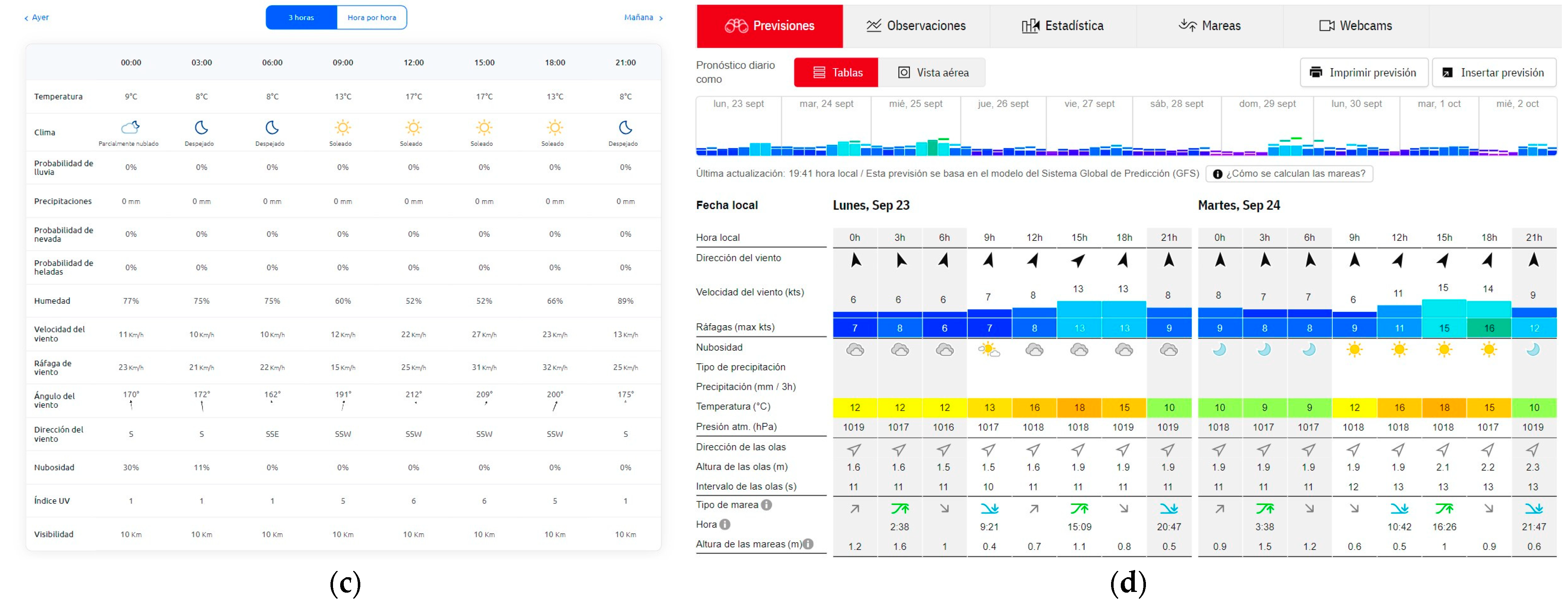
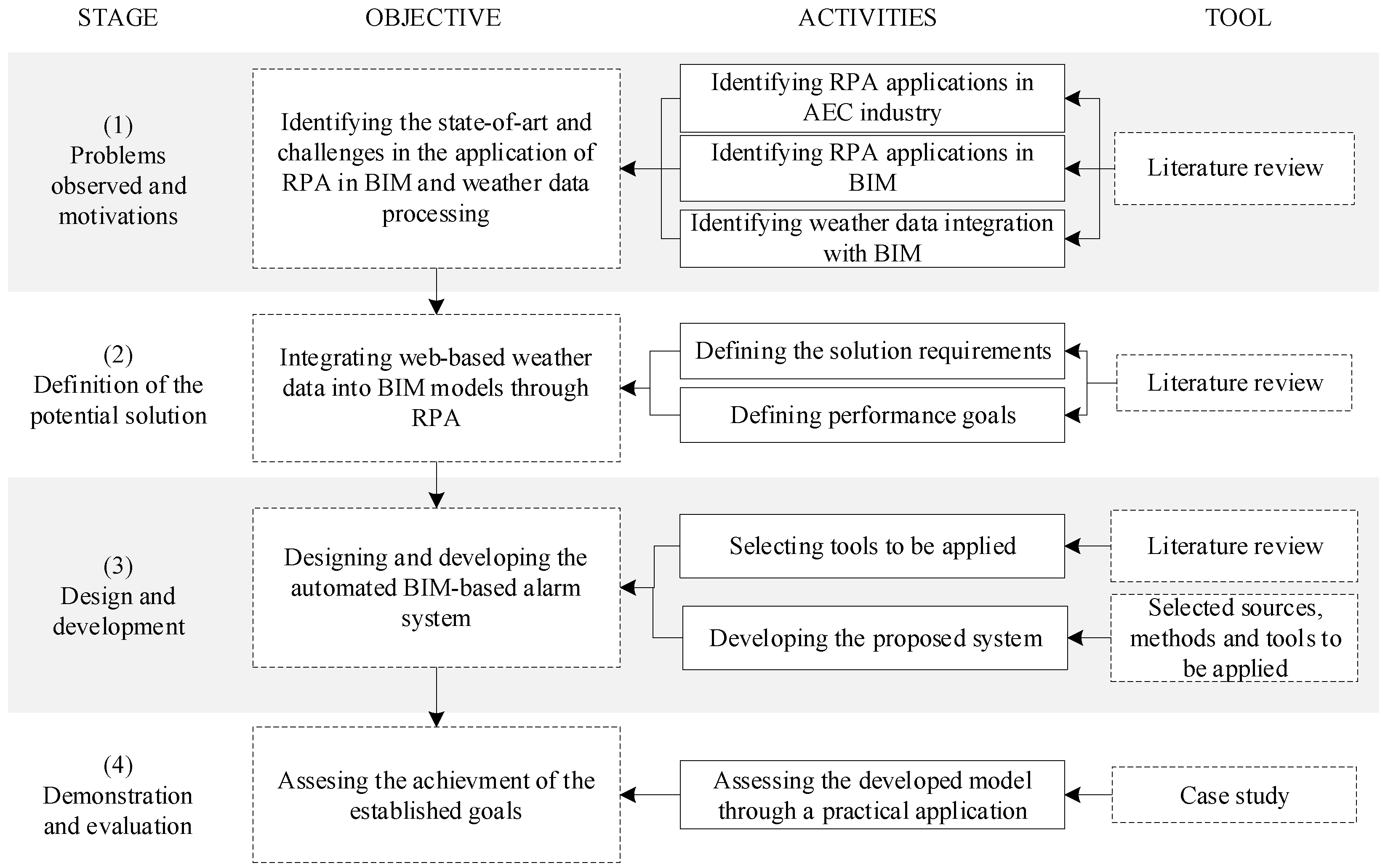
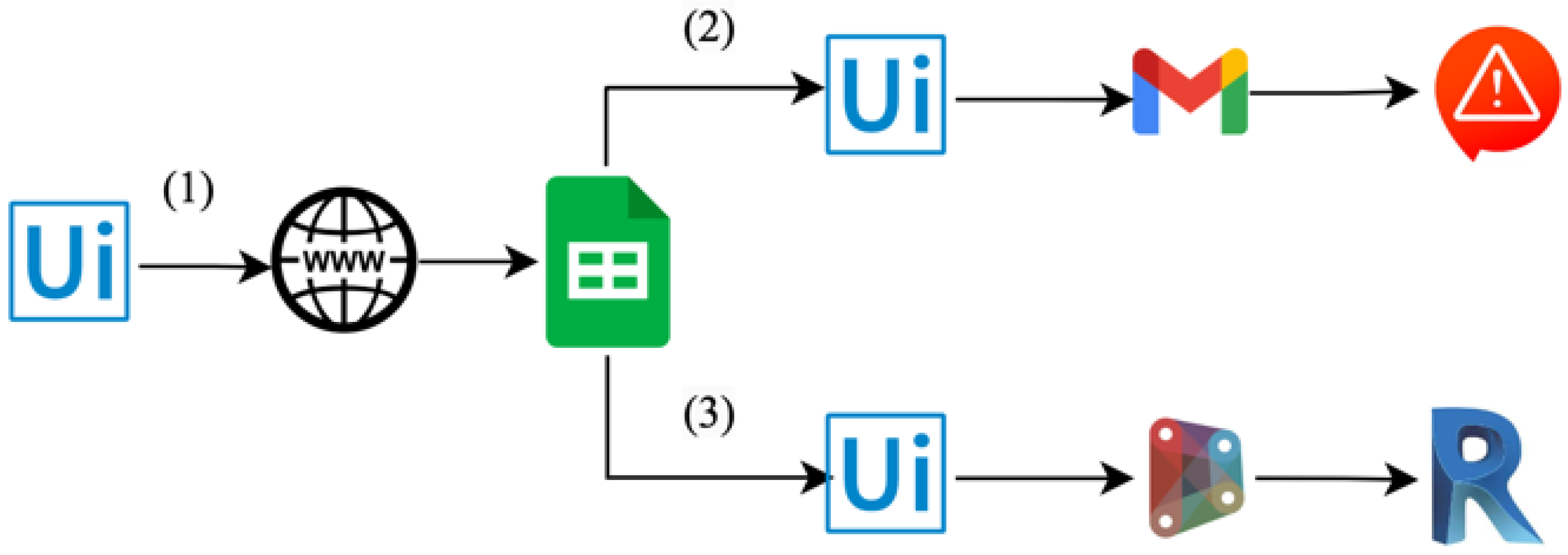




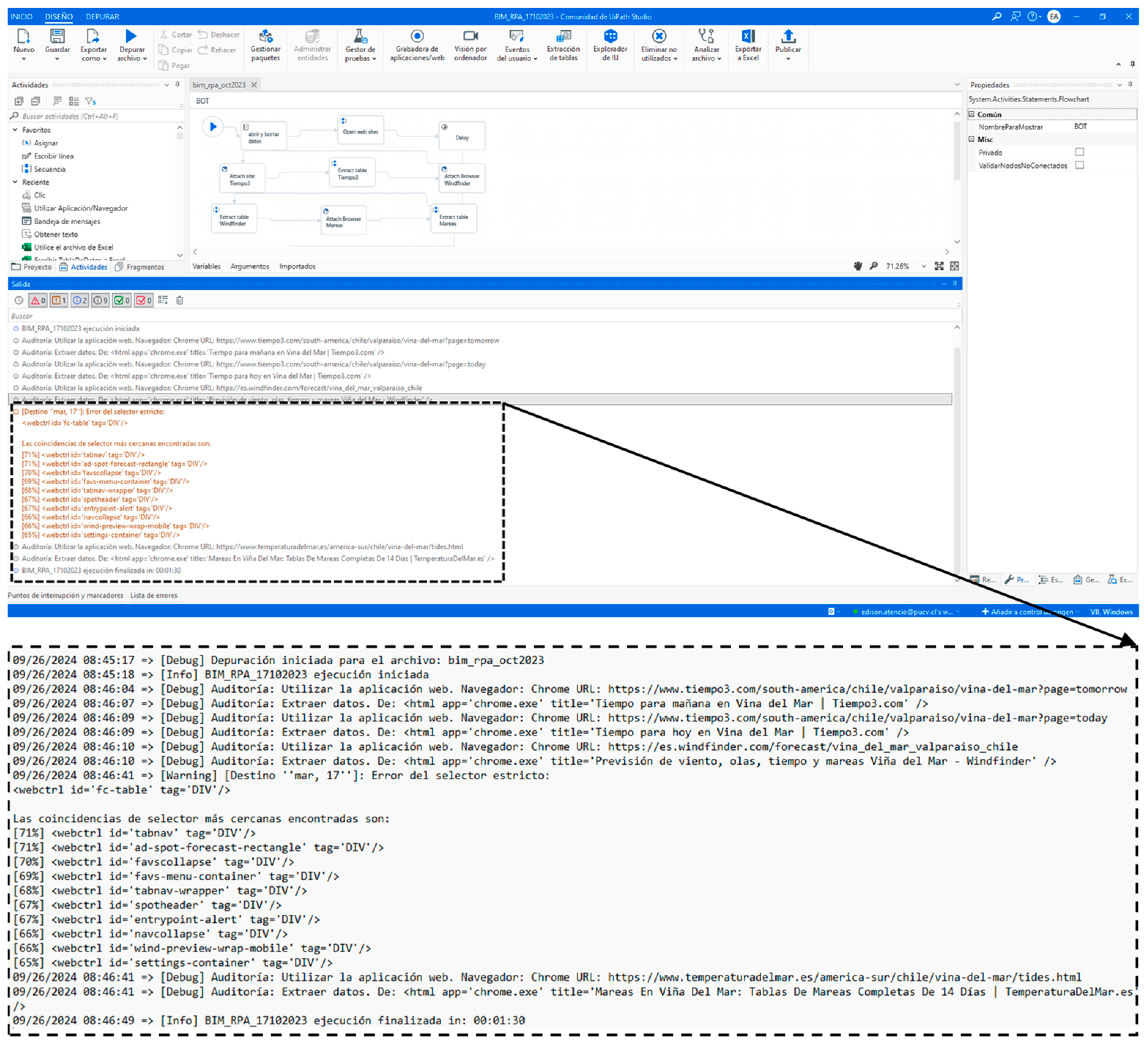
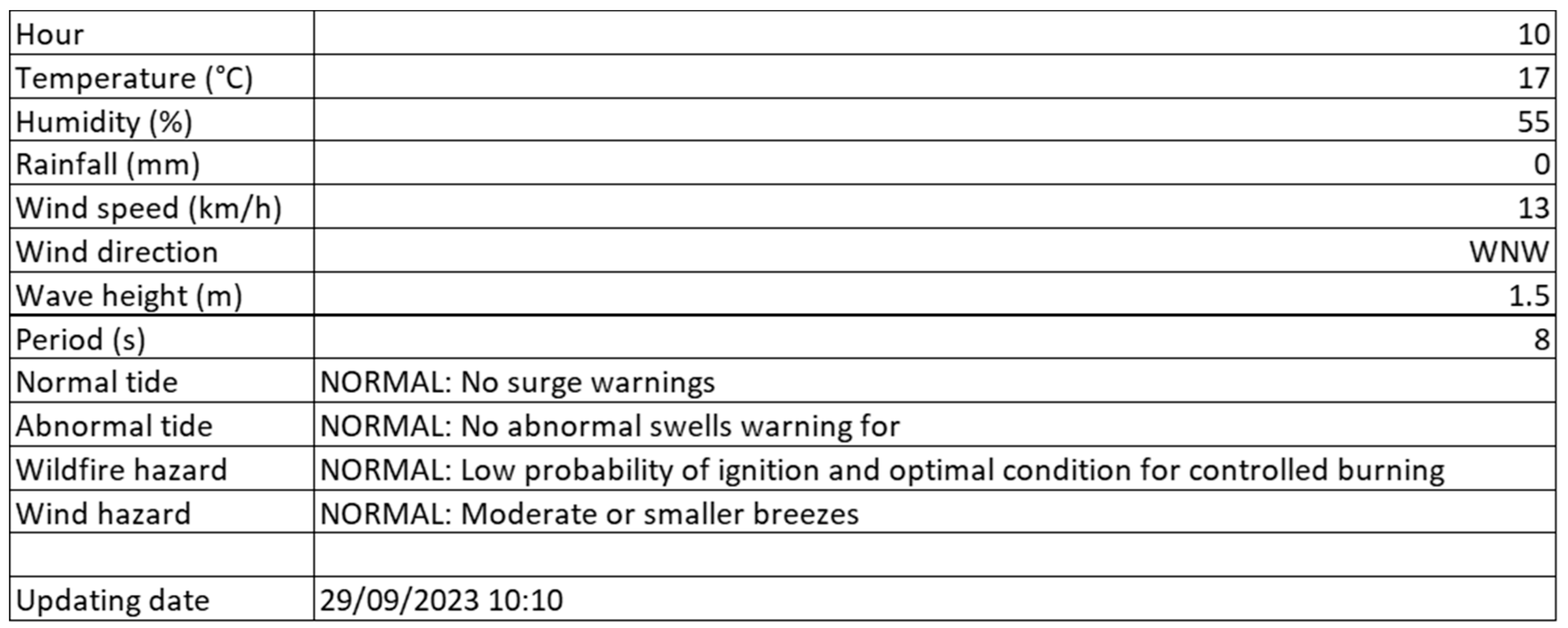
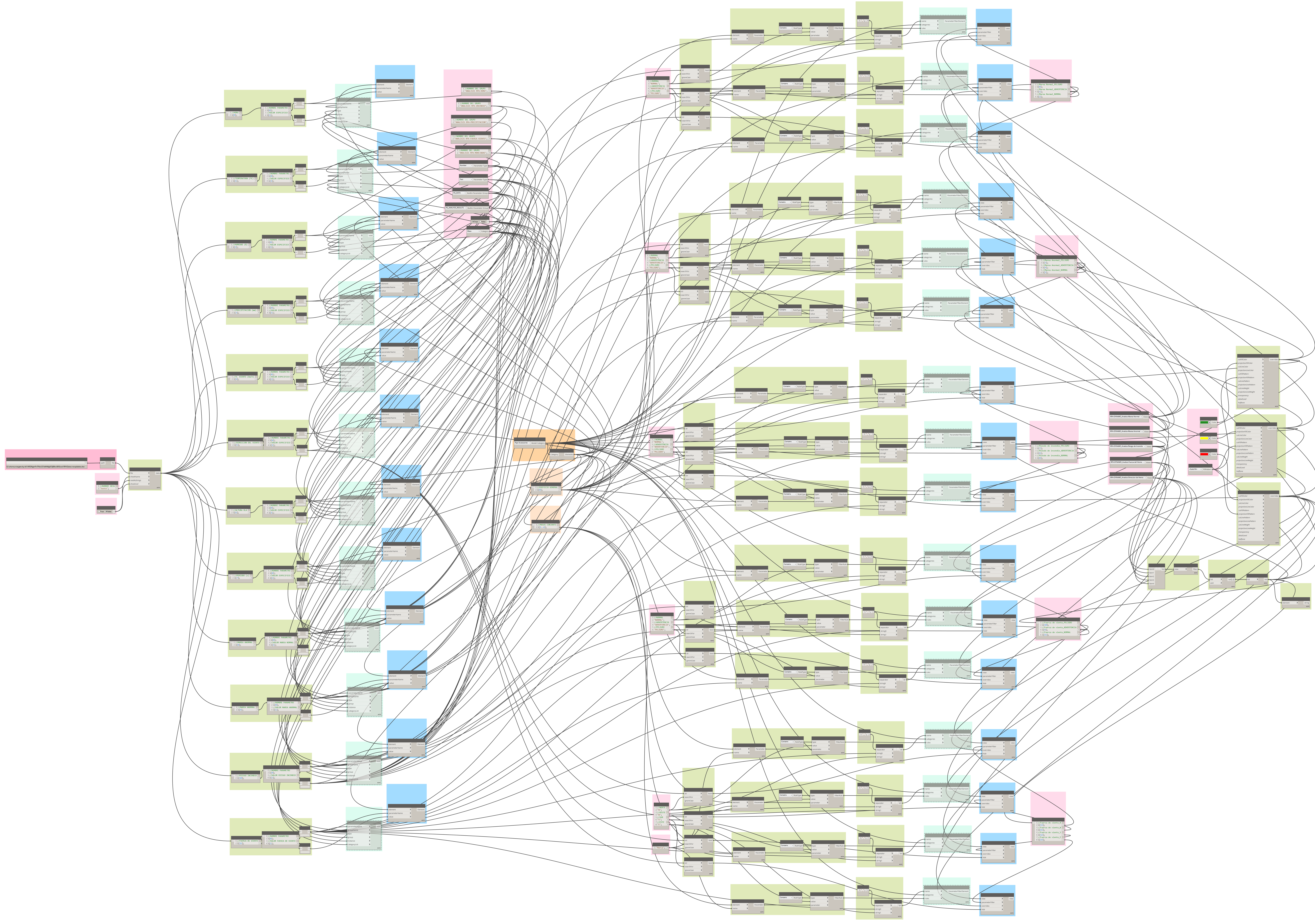

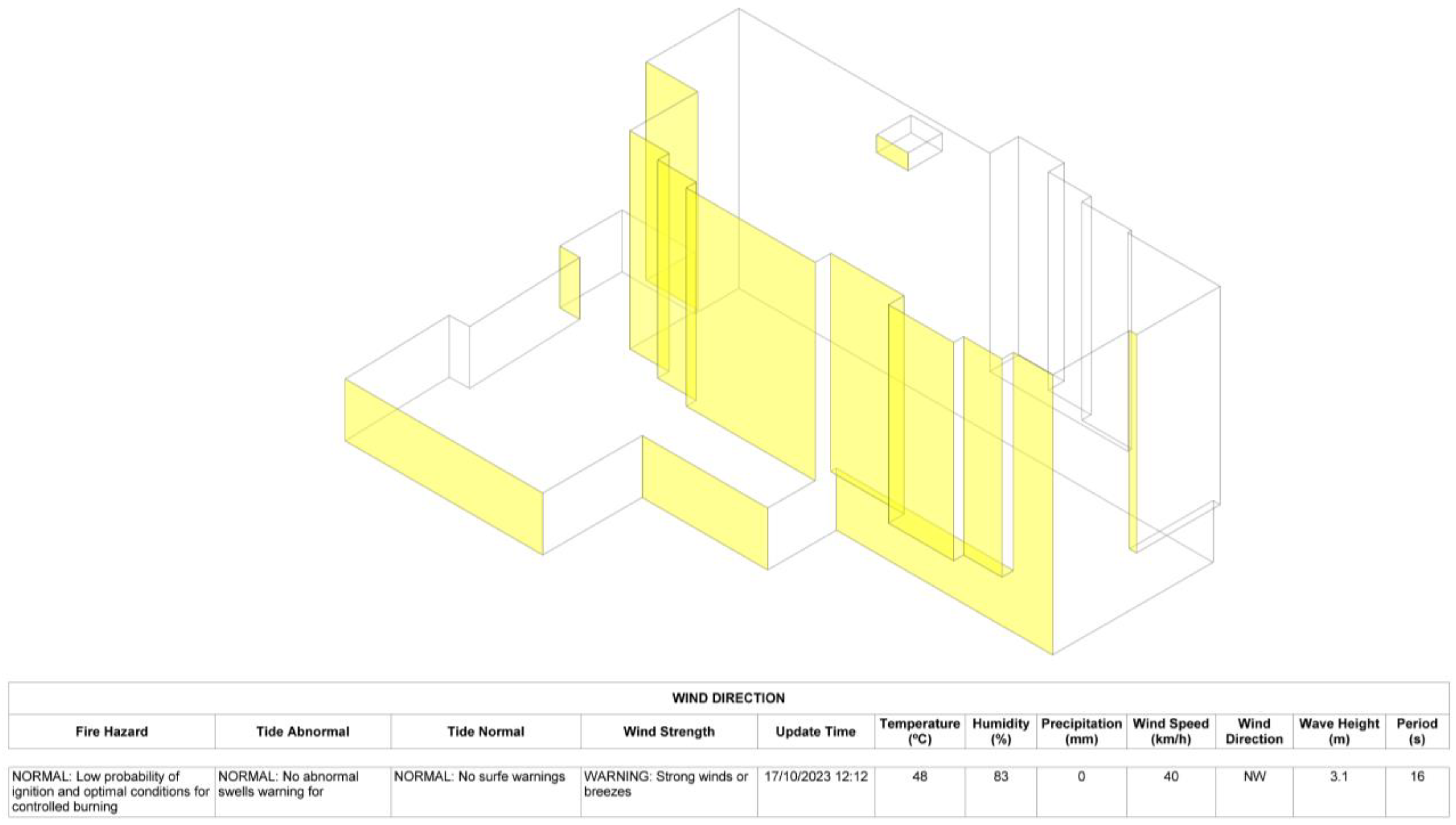
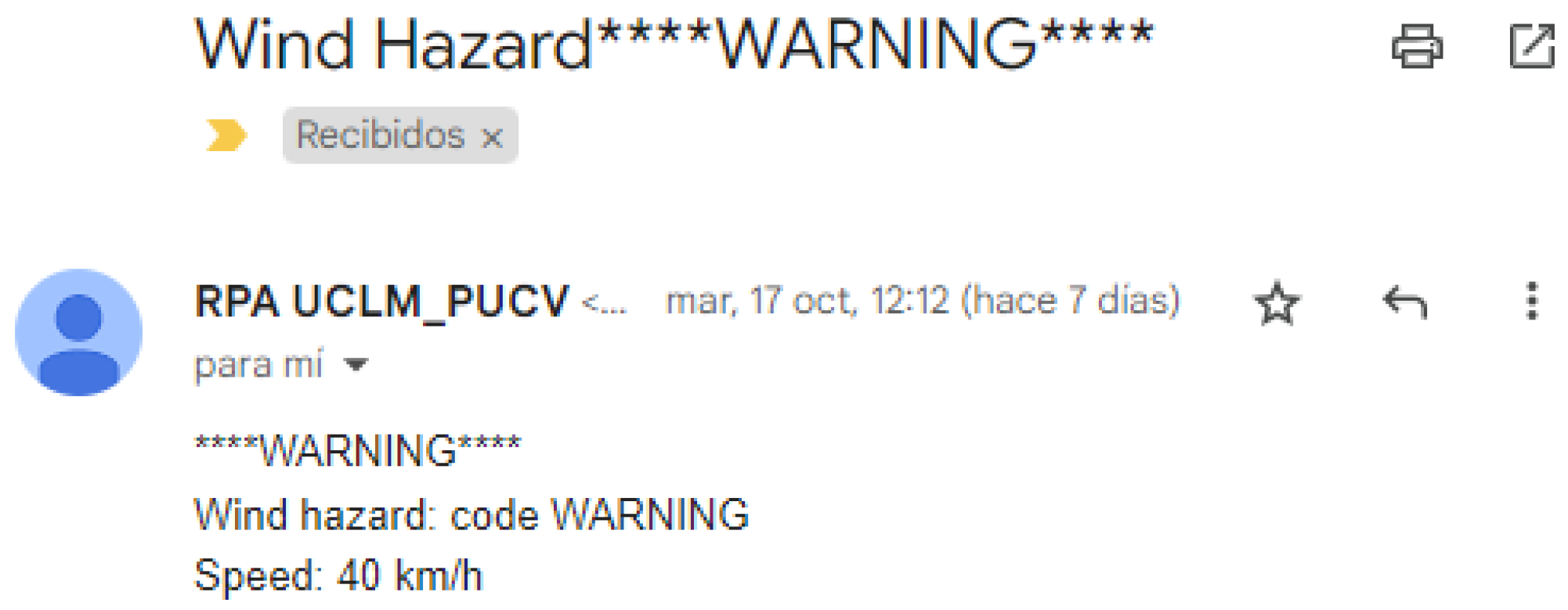
| Weather Parameter | Updating Frequency | Website |
|---|---|---|
| Temperature [°C] Humidity [%] Wind speed [km/h] Wind direction [direction] Rain [mm] | 1 h | [94] |
| Tide [m] | 8 h | [95] |
| Wave [m] | 2 h | [50] |
| Alert | Risk Index | Wind Speed [km/h] |
|---|---|---|
| Normal | <40 | <38 |
| Warning | >40 and ≤55 | >38 and ≤88 |
| Danger | >55 | >88 |
| Alert | Wave Direction | Wave Height [m] | Wave Period [m] |
|---|---|---|---|
| Normal | Not considered | <2 | ≥18 |
| Warning | NW | ≥2 and <4 | >14 and <18 |
| Danger | SW or W | ≥4 | Not considered |
Disclaimer/Publisher’s Note: The statements, opinions and data contained in all publications are solely those of the individual author(s) and contributor(s) and not of MDPI and/or the editor(s). MDPI and/or the editor(s) disclaim responsibility for any injury to people or property resulting from any ideas, methods, instructions or products referred to in the content. |
© 2024 by the authors. Licensee MDPI, Basel, Switzerland. This article is an open access article distributed under the terms and conditions of the Creative Commons Attribution (CC BY) license (https://creativecommons.org/licenses/by/4.0/).
Share and Cite
Atencio, E.; Lozano, F.; Alfaro, I.; Lozano-Galant, J.A.; Muñoz-La Rivera, F. Integrating Web-Based Weather Data into Building Information Modeling Models through Robot Process Automation. Appl. Sci. 2024, 14, 9109. https://doi.org/10.3390/app14199109
Atencio E, Lozano F, Alfaro I, Lozano-Galant JA, Muñoz-La Rivera F. Integrating Web-Based Weather Data into Building Information Modeling Models through Robot Process Automation. Applied Sciences. 2024; 14(19):9109. https://doi.org/10.3390/app14199109
Chicago/Turabian StyleAtencio, Edison, Fidel Lozano, Ignacio Alfaro, Jose Antonio Lozano-Galant, and Felipe Muñoz-La Rivera. 2024. "Integrating Web-Based Weather Data into Building Information Modeling Models through Robot Process Automation" Applied Sciences 14, no. 19: 9109. https://doi.org/10.3390/app14199109









